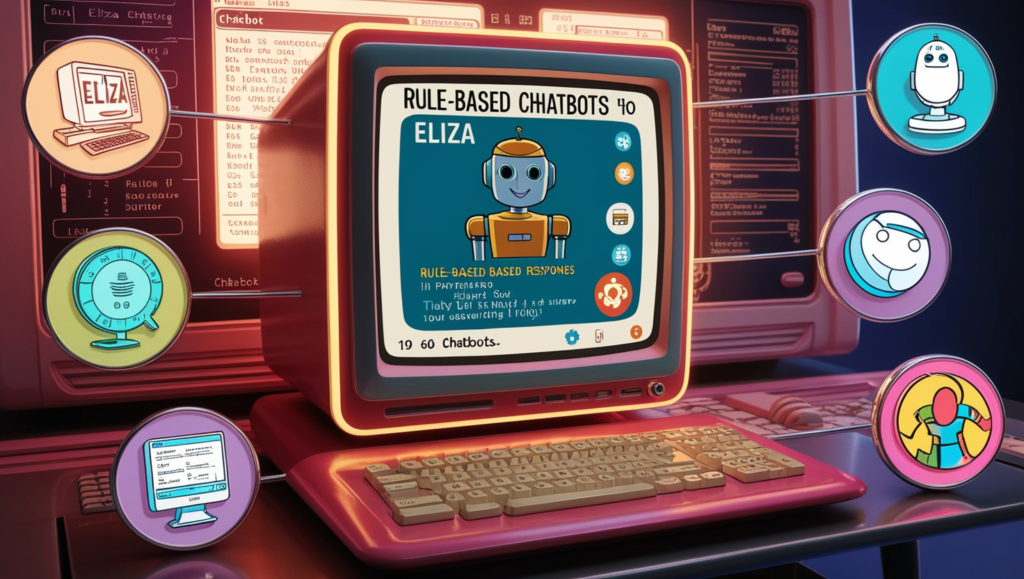From being simple automated responders to where they are now, chatbots have grown by leaps and bounds. Chatbots are virtual assistants that have evolved from customer care representatives to personalized help and conversation. It becomes a critical component of a digital experience because of characteristics such as emotional intelligence, hyper-personalization, and smooth interaction with other technologies, which changes everything about how we engage and communicate with services.
THE CHATBOT EVOLUTION YOU NEED TO KNOW
Rule-Based Chatbots – The Early Days
The chatbots were initially developed upon rule-based algorithms. The former was not only rigid but under-functional as well, for it could only answer the given set of pre-programmed questions.
ELIZA, which came up during the 1960s, was a sort of tool basically used for the simulation of human talk and was not very efficient for understanding or adapting to more complex inputs.

The early chatbots were primarily applied to narrowly focus on programs such as FAQs in customer service. Such early programs were successful but frustrated users in the inability of the programs to make sense of unexpected inputs or followup questions.
This has been the most significant mark in the history of development of the chatbots; it integrated them with Artificial Intelligence, which includes specifically Natural Language Processing (NLP) and Machine Learning (ML). This integrated understanding even helps in recognizing the context of words spoken by the user and that the words uttered can better be identified to be associated with any human language and thus become better processed by the chatbots.
This revolution of AI-powered chatbots does the following:
1. Contextual and sentiment awareness.
2. Dealing with heterogeneous and unstructured input streams.
3. Improving over time, through interaction.
With these improvements, chatbots transitioned from being static tools to dynamic conversational agents. They became indispensable for customer support, reduced response times, and increased user satisfaction.
The Age of Conversational AI
Today, conversational AI refers to: natural human-like dialogues from systems. The future generation of chatbots rely on the advanced models that generate coherent responses with regard to the context. **Transformers** are a form of these models.
Main features of conversational AI
Multi-turn conversations: Continue back-and-forth dialogue with memory of previous interactions.
Personalization: adaptation to user preferences and needs
Multimodal interactions: text, voice, and visual in unison can be used to enhance communication.
Applications of conversational AI now run from customer support to education, entertainment, health care, and personal productivity.
From Customer Support to Virtual Companions
The majority of customer service applications are still in the domain of chatbots. The chatbots, however have diversified. The chatbots of today can be classified as virtual companions that could help the user in many areas of life.
1. Mental Health and Wellbeing
These chatbots, like Woebot, can offer mental support in terms of stress management, anxiety handling, and depression management. Such virtual companions provide users with an opportunity to express themselves freely in a completely safe space where one fears no judgment.
2. Personal Assistants
These bots have allowed people to monitor their schedules, reminders about significant events, and even to find information easily via Siri and Google Assistant.
3. Learning and Skill Development
Academic-oriented bots like the Duolingo Bot teach learning a new language fully interactively but all in customizable learning interactions for education.
4. Entertainment and Company.
Chatbots have started engaging people in stories, playing with them and even casual everyday chats in order to entertain lonely, loneliness-stricken souls wanting company.
Near Future Chatbots
Some of the areas that near future chatbot development would probably include:
Hyper-personalization: Personalizing interaction on an entirely new scale to individual user.
Emotional Intelligence: Improves ability to identify and react on human emotions.
Seamless Integration: Collaboration of other smart devices to produce an integrative experience.
Human-AI Collaborations: Collaborating as partners will make the collaboration better at the time of decision-making or production.
From static scripts to human-like conversations, from just a simple chatbot to now being a powerful tool in shaping our digital interactions, from customer support agents to virtual companions, chatbots are redefining the relationships between humans and technology. The journey is far from over, and possibilities are endless, making this the evolution of chatbots an interesting story in the AI era.
It is some part of chatbot evolution you need to know.




One thought on “The Chatbot Evolution You Need to Know : From Support to Companionship”